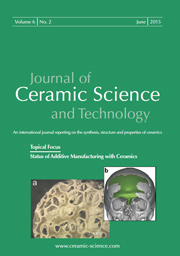Articles
All articles | Recent articles
Water-Glass-Based Composite Materials – Investigation into their Thermal Conductivity
R.A. Shishkin
Ural Federal University, Yekaterinburg, Russian Federation
received November 16, 2014, received in revised form January 15, 2015, accepted January 30, 2015
Vol. 6, No. 3, Pages 231-236 DOI: 10.4416/JCST2014-00050
Abstract
Inorganic water-glass-based thermal pastes exhibit a higher thermal conductivity coefficient than silicon-based pastes. They can also be used at elevated temperatures. The dependence of thermal conductivity on filler content, curing agent, urea and hybrid fillers is studied. Special attention is paid to the curing chemistry of the thermal pastes during manufacturing. As a result, a number of composite materials with a significant improvement in thermal conductivity has been produced.
![]() Download Full Article (PDF)
Download Full Article (PDF)
Keywords
Thermal paste, thermal conductivity, composite material, magnesium oxide, water glass
References
1 Yung, K.C., Liem, H., Choy, H.S.: Heat dissipation performance of a high-brightness LED package assembly using high-thermal conductivity filler, Appl. Optics, 35, [52], 8484 – 8493, (2013).
2 Anithambigai, P., Shanmugan, S., Mutharasu, D., Zahner, T., Lacey, D.: Study on thermal performance of high power LED employing aluminium filled epoxy composite as thermal interface material, 19th International Workshop on Thermal Investigations of ICS and Systems (Thermic), 181 – 187, (2013).
3 Shen, Q., Sun, D., Xu, Y., Jin, T., Zhao, X.: Orientation effects on natural convection heat dissipation of rectangular fin heat sinks mounted on LEDs, Int. J. Heat Mass Tran., 75, 462 – 469, (2014).
4 Yu, J., Lacy Jr., T.E., Toghiani, H., Pittman Jr., C.U.: Micromechanically-based effective thermal conductivity estimates for polymer nanocomposites, Compos. Part B-Eng., 53, 267 – 273, (2013).
5 Wang, S., Qiu, J.: Enhancing thermal conductivity of glass fiber/polymer composites through carbon nanotubes incorporation, Compos. Part B-Eng., 7, [41], 533 – 536, (2010).
6 Harada, M., Hamaura, N., Ochi, M., Agari, Y.: Thermal conductivity of liquid crystalline epoxy/BN filler composites having ordered network structure, Compos. Part B-Eng., 55, 306 – 313, (2013).
7 Choi, S., Kim, J.: Thermal conductivity of epoxy composites with a binary-particle system of aluminum oxide and aluminum nitride fillers, Compos. Part B-Eng., 51, 140 – 147, (2013).
8 Gardea, F., Lagoudas, D.C.: Characterization of electrical and thermal properties of carbon nanotube/epoxy composites, Compos. Part B-Eng., 56, 611 – 620, (2014).
9 Ren, L., Pashayi, K., Fard, H.R., Kotha, S.P., Borca-Tasciuc, T., Ozisik, R.: Engineering the coefficient of thermal expansion and thermal conductivity of polymers filled with high aspect ratio silica nanofibers, Compos. Part B-Eng., 58, 228 – 234, (2014).
10 Shishkin, R.A., Erkhova, N.A., Beketov, A.R., Elagin, A.A.: Water-glass-based thermal paste for high temperature applications, J. Ceram. Sci. Tech., 5, 199 – 202, (2014).
11 Duderov, Y.G., Duderov, I.G.: Ceramic technology calculations: Handbook, Moscow, Stroyizdat, 80, (1973).
12 Iler, R.K.: The chemistry of silica: Solubility, polymerization, colloid and surface properties and biochemistry of silica, M. Mir, 892, (1982).
13 Park, J.M., Kwon, D.J., Wang, Z.J., Roh, J.U., Lee, W.I., Park, J.K., DeVries, K.L.: Effects of carbon nanotubes and carbon fiber reinforcements on thermal conductivity and ablation properties of carbon/phenolic composites, Compos. Part B-Eng., 67, 22 – 29, (2014).
14 Lachheb, M., Mustapha, K., Fethi, A., Sassi, B.N., Magali, F., Patrik, S.: Thermal properties measurement and heat storage analysis of paraffin/graphite composite phase change material. Compos. Part B-Eng., 66, 518 – 525, (2014).
15 Chen J.K., Huang I.S.: Thermal properties of aluminum-graphite composites by powder metallurgy. Compos. Part B-Eng., 44, 698 – 703, (2013).
Copyright
Göller Verlag GmbH


